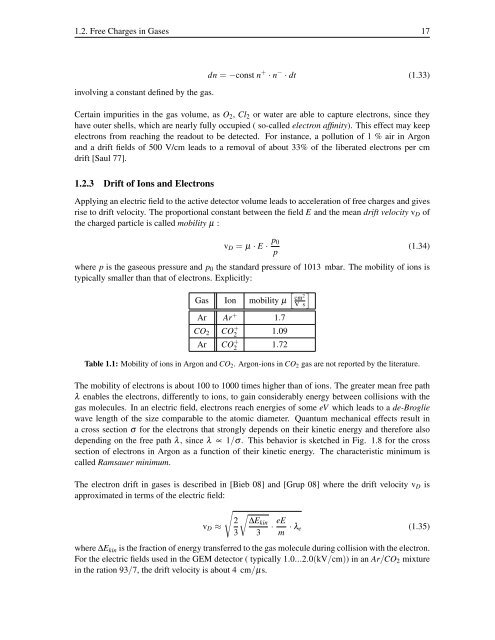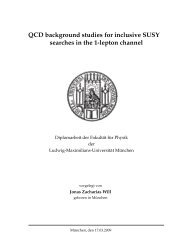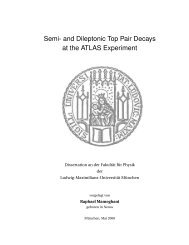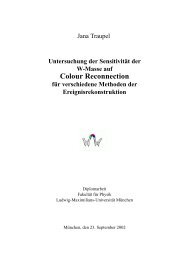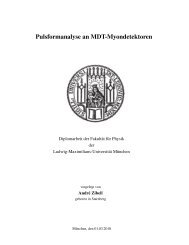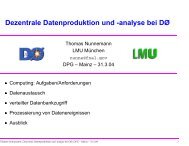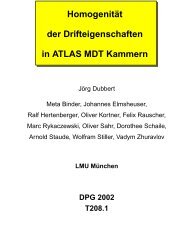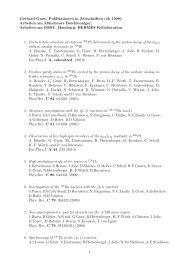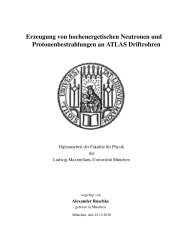development of micro-pattern gaseous detectors – gem - LMU
development of micro-pattern gaseous detectors – gem - LMU
development of micro-pattern gaseous detectors – gem - LMU
You also want an ePaper? Increase the reach of your titles
YUMPU automatically turns print PDFs into web optimized ePapers that Google loves.
1.2. Free Charges in Gases 17<br />
involving a constant defined by the gas.<br />
dn = −const n + · n − · dt (1.33)<br />
Certain impurities in the gas volume, as O2, Cl2 or water are able to capture electrons, since they<br />
have outer shells, which are nearly fully occupied ( so-called electron affinity). This effect may keep<br />
electrons from reaching the readout to be detected. For instance, a pollution <strong>of</strong> 1 % air in Argon<br />
and a drift fields <strong>of</strong> 500 V/cm leads to a removal <strong>of</strong> about 33% <strong>of</strong> the liberated electrons per cm<br />
drift [Saul 77].<br />
1.2.3 Drift <strong>of</strong> Ions and Electrons<br />
Applying an electric field to the active detector volume leads to acceleration <strong>of</strong> free charges and gives<br />
rise to drift velocity. The proportional constant between the field E and the mean drift velocity vD <strong>of</strong><br />
the charged particle is called mobility µ :<br />
vD = µ · E · p0<br />
p<br />
(1.34)<br />
where p is the <strong>gaseous</strong> pressure and p0 the standard pressure <strong>of</strong> 1013 mbar. The mobility <strong>of</strong> ions is<br />
typically smaller than that <strong>of</strong> electrons. Explicitly:<br />
<br />
cm2 Gas Ion mobility µ V s<br />
Ar Ar + 1.7<br />
CO2 CO + 2 1.09<br />
Ar CO + 2 1.72<br />
Table 1.1: Mobility <strong>of</strong> ions in Argon and CO2. Argon-ions in CO2 gas are not reported by the literature.<br />
The mobility <strong>of</strong> electrons is about 100 to 1000 times higher than <strong>of</strong> ions. The greater mean free path<br />
λ enables the electrons, differently to ions, to gain considerably energy between collisions with the<br />
gas molecules. In an electric field, electrons reach energies <strong>of</strong> some eV which leads to a de-Broglie<br />
wave length <strong>of</strong> the size comparable to the atomic diameter. Quantum mechanical effects result in<br />
a cross section σ for the electrons that strongly depends on their kinetic energy and therefore also<br />
depending on the free path λ, since λ ∝ 1/σ. This behavior is sketched in Fig. 1.8 for the cross<br />
section <strong>of</strong> electrons in Argon as a function <strong>of</strong> their kinetic energy. The characteristic minimum is<br />
called Ramsauer minimum.<br />
The electron drift in gases is described in [Bieb 08] and [Grup 08] where the drift velocity vD is<br />
approximated in terms <strong>of</strong> the electric field:<br />
vD ≈<br />
<br />
<br />
2 ∆Ekin<br />
3 3<br />
· eE<br />
m<br />
· λe<br />
(1.35)<br />
where ∆Ekin is the fraction <strong>of</strong> energy transferred to the gas molecule during collision with the electron.<br />
For the electric fields used in the GEM detector ( typically 1.0...2.0(kV/cm)) in an Ar/CO2 mixture<br />
in the ration 93/7, the drift velocity is about 4 cm/µs.


